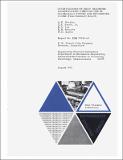| dc.contributor.author | Bergles A. E. | en_US |
| dc.contributor.author | Brown, G. S. | en_US |
| dc.contributor.author | Lee, R. A. | en_US |
| dc.contributor.author | Simonds, Richard R. | en_US |
| dc.contributor.author | Snider, Warren Dean. | en_US |
| dc.contributor.other | Massachusetts Institute of Technology. Division of Sponsored Research. | en_US |
| dc.contributor.other | Massachusetts Institute of Technology. Dept. of Mechanical Engineering. | en_US |
| dc.contributor.other | Massachusetts Institute of Technology. Heat Transfer Laboratory. | en_US |
| dc.date.accessioned | 2011-03-04T23:39:07Z | |
| dc.date.available | 2011-03-04T23:39:07Z | |
| dc.date.issued | 1970 | en_US |
| dc.identifier | 14083467 | en_US |
| dc.identifier.uri | http://hdl.handle.net/1721.1/61497 | |
| dc.description.abstract | This report summarizes a three-year program concerned with obtaining basic design information for tubes having a random roughness on the inside wall (RID) and tubing having continuous internal fins (Forge Fin). Test apparatus and procedures were developed to obtain accurate heat-transfer and friction data for a wide variety of tube geometries using water as the test fluid. For the random roughness the heat-transfer coefficient was above the smooth tube value, for comparable flow conditions, by over 60 percent at a Reynolds number of 30,000. Larger percentage improvements can be expected for higher Reynolds numbers and for fluids having higher Prandtl numbers. Improvements in performance, based on equal pumping power for augmented and smooth tubes, of about 50 percent were observed. The heat-transfer characteristics for tape-generated swirl flow through rough tubes were investigated in order to determine the interaction of swirl flow and roughness effects. For the particular range of parameters covered, for equal flow rates, the maximum improvement in heat transfer with swirl flow in smooth tubes was 70 percent, whereas with swirl flow in rough tubes, the improvement was as much as 100 percent. The heat-transfer coefficient for rough tube swirl flow was accurately correlated by a modification of an additive expression previously suggested for prediction of smooth tube swirl flow data. | en_US |
| dc.description.abstract | (cont.) The test program for internally finned tubes established that short spiralled fins produce the greatest improvement in heat transfer. On the basis of equal flow conditions, the heat transfer was improved by over 200 percent; while at equal pumping power, the performance was as high as 170 percent. These improvements, which are attributed to increased area and turbulence promotion, appear to equal the improvements displayed by any of the schemes used to augment heat transfer inside tubes. In order to bring the augmentation problem into perspective, a discussion of data for other types of roughness and finning is included. | en_US |
| dc.description.sponsorship | DSR | en_US |
| dc.format.extent | viii, 98 p | en_US |
| dc.publisher | Cambridge, Mass. : M.I.T. Heat Transfer Laboratory, [1970] | en_US |
| dc.relation.ispartofseries | Technical report (Massachusetts Institute of Technology, Heat Transfer Laboratory) ; no. 69. | en_US |
| dc.subject | Heat -- Transmission. | en_US |
| dc.subject | Tubes -- Fluid dynamics. | en_US |
| dc.title | Investigation of heat transfer augmentation through use of internally finned and roughened tubes : final summary report | en_US |
| dc.type | Technical Report | en_US |
